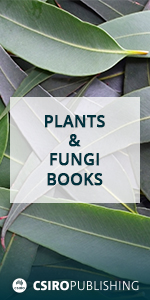
Functional Plant Biology
Volume 42 Number 9 2015
FP15060What drives fruit growth?
Although plant growth through aggregation of number and size of tissues and organs seems straightforward, the cellular basis of fruit growth is still unresolved. We argue that (1) the positive correlation between cell number and fruit size does not imply a causal relationship, and (2) fruit growth is regulated by a global protein through cell autonomous and noncell autonomous mechanisms. We propose that fruit size can be manipulated via genes regulating cell division or cell expansion.
FP15077A thermodynamic analysis of the feasibility of water secretion into xylem vessels against a water potential gradient
The energetic aspects of water secretion into root xylem vessels by cotransport with salts were analysed by assuming water transport to be ‘energetically uphill’ and associated with a free energy gain of water. This paper shows that despite considerable energy costs, root respiration and H+-ATPase activity could drive secondary active water transport. This may contribute to the generation of root pressure, embolism repair and water ascent in trees.
FP14256Rising temperature may negate the stimulatory effect of rising CO2 on growth and physiology of Wollemi pine (Wollemia nobilis)
Wollemi pine, formerly widespread in Australia, has been reduced by past climate change to a remnant population and this rare species may be pushed to extinction by future climate change. We examined the impact of rising [CO2] and temperature on clonally propagated seedlings, and observed positive impacts on growth and physiology in elevated [CO2] that were generally negated by elevated temperature. The remnant wild population of Wollemi pine is susceptible to warming, which may be the most significant environmental factor determining success in a future climate.
FP14279Optimum temperature for floral terpene emissions tracks the mean temperature of the flowering season
Flower scent plays a crucial role in pollinator attraction and is affected by environmental conditions such as temperature. We tested whether optimum temperatures for floral emissions are adapted to the temperature range during the flowering period and found that species flowering in cold seasons have lower optimum temperatures than those flowering in warm seasons. The results suggest that the flower physiology of different species is adapted to optimise emissions during their flowering period.
FP15024High resolution imaging of maize (Zea mays) leaf temperature in the field: the key role of the regions of interest
Remote sensing technologies have the potential to help scientists, breeders and decision makers to assess the extent to which crops are affected by drought. This paper evaluates some benefits of high spatial resolution for thermal imaging applications in field conditions. The study indicates that careful selection of information-rich areas in canopy images captures temperature differences that are filtered out in lower resolution configurations.
FP15019Ultrastructural and biochemical changes induced by salt stress in Jatropha curcas seeds during germination and seedling development
Jatropha curcas emerges as potential energy source but the effects of NaCl stress on germination and seed reserves are poorly known. Salt stress delays protein and lipid mobilisation and promotes ultrastructural changes in endosperm cells. Seed germination of J. curcas is inhibited through increase the Na+ and Cl– accumulation in the embryo axes and endosperm of seeds.
FP14363Compact panicle architecture is detrimental for growth as well as sucrose synthase activity of developing rice kernels
Poor synthesis of starch in the grains on the basal part of rice panicle of modern rice cultivars underscores their potential for high grain yield. The study identified genetic expression of starch synthesising enzymes, particularly sucrose synthase, poor in the in the inferior type grains. Harnessing high yield in these rice cultivars need genetic manipulation of the enzyme for improved grain filling.
FP14324The hydraulic architecture of Eucalyptus trees growing across a gradient of depth-to-groundwater
Over extraction of groundwater is a serious problem globally because it negatively impacts on groundwater dependent vegetation. This paper compares the hydraulic architecture of Eucalyptus woodlands across a naturally occurring gradient of depth-to-groundwater and shows that significant variation in hydraulic traits occurs in response to differences in depth-to-groundwater. This is the first such study in a mesic environment and shows even in high rainfall zones extraction of groundwater require careful control.
FP15035Constitutively overexpressing a tomato fructokinase gene (LeFRK1) in cotton (Gossypium hirsutum L. cv. Coker 312) positively affects plant vegetative growth, boll number and seed cotton yield
Increasing gene expression for the fructokinase that phosphorylates fructose in cotton improves seed cotton and fibre yield through positive effects on seed number per boll, boll number, leaf number and area, and stem diameter. We hypothesise that some processes associated with cotton development are constrained by fructose inhibition of the sucrose synthase required for sucrose metabolism in growing cells. Improving fructokinase activity may improve fibre yield through its indirect effects on photosynthetic capacity.
FP14361Effects of elevated temperature on sucrose metabolism and cellulose synthesis in cotton fibre during secondary cell wall development
Global warming has posed a major threat to cotton fibre development. This work shows that elevated temperature had negative impacts on sucrose metabolism and on cellulose synthesis in cotton fibre during fibre secondary wall development. Our results suggest that the cellulose content in cotton fibre is positively correlated with temperatures above 15°C but under 30°C.




